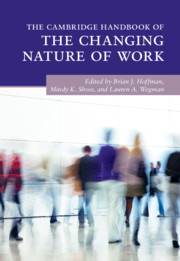Book contents
- The Cambridge Handbook of the Changing Nature of Work
- The Cambridge Handbook of the Changing Nature of Work
- Copyright page
- Contents
- Figures
- Tables
- Contributors
- Part I Introduction to the Changing Nature of Work
- Part II What Has Changed?
- 4 Changes in Technology
- 5 The Changing Nature of Work
- 6 Changes in Occupations, Jobs, and Skill Polarization
- 7 Changes in the Legal Landscape
- 8 The Rise and Decline of Organized Labor in the United States
- 9 Changes in Organizational Income Inequality
- 10 Work and Employment in Fluid Organizational Forms
- 11 Changes in Worker Demographics
- 12 Generational Changes in Personality, Values, and Abilities
- 13 Changes in Work Behavior Patterns
- Part III Implications for Talent Management and Impact on Employees
- Index
- References
4 - Changes in Technology
from Part II - What Has Changed?
Published online by Cambridge University Press: 02 April 2020
- The Cambridge Handbook of the Changing Nature of Work
- The Cambridge Handbook of the Changing Nature of Work
- Copyright page
- Contents
- Figures
- Tables
- Contributors
- Part I Introduction to the Changing Nature of Work
- Part II What Has Changed?
- 4 Changes in Technology
- 5 The Changing Nature of Work
- 6 Changes in Occupations, Jobs, and Skill Polarization
- 7 Changes in the Legal Landscape
- 8 The Rise and Decline of Organized Labor in the United States
- 9 Changes in Organizational Income Inequality
- 10 Work and Employment in Fluid Organizational Forms
- 11 Changes in Worker Demographics
- 12 Generational Changes in Personality, Values, and Abilities
- 13 Changes in Work Behavior Patterns
- Part III Implications for Talent Management and Impact on Employees
- Index
- References
Summary
This chapter accomplishes three primary goals. First, we review the history of technologies that have been influential in the world of work, from the abacus to innovations of the present day. We then identify eight characteristics that describe modern technologies: power, portability, usability, networking, encryption, ubiquity, immersion, and predictiveness. Finally, we present a SWOT analysis that identifies the implications of these characteristics for the future of work. In doing so, we demonstrate that although technological change is a constant, so too is humans’ ability to adapt to change.
Keywords
Information
- Type
- Chapter
- Information
- The Cambridge Handbook of the Changing Nature of Work , pp. 69 - 100Publisher: Cambridge University PressPrint publication year: 2020
References
Accessibility standard: Unknown
Why this information is here
This section outlines the accessibility features of this content - including support for screen readers, full keyboard navigation and high-contrast display options. This may not be relevant for you.Accessibility Information
- 2
- Cited by
